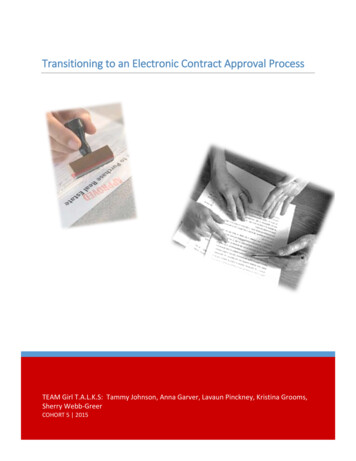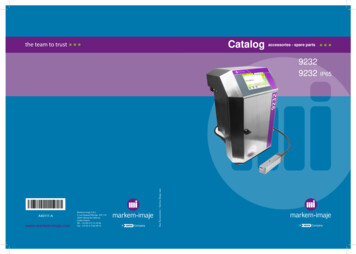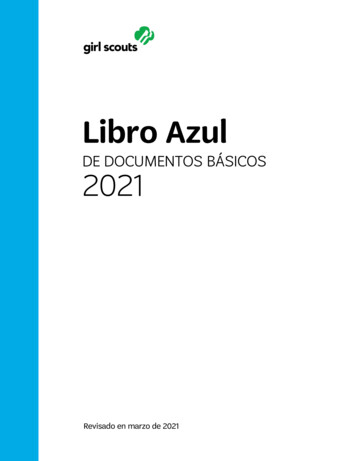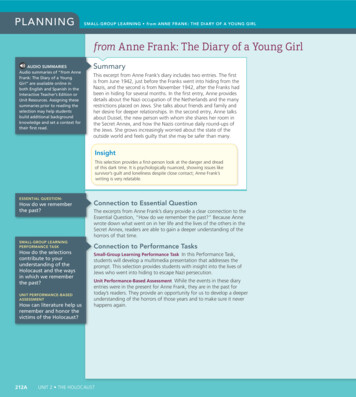
Transcription
TEAM Girl T.A.L.K.S: Tammy Johnson, Anna Garver, Lavaun Pinckney, Kristina Grooms,Sherry Webb-GreerCOHORT 5 2015
TRANSITIONING TO AN ELECTRONIC CONTRACT APPROVAL PROCESSTable of ContentsExecutive Summary . 2Introduction (Problem Statement). 3Background . 3Research Strategies . 4SharePoint – Department of Education . 5Workflow Integrated System Enterprise (WISE) – Model View Controller Framework,ASP.net Coding– DOH. 6Intellivue – Department of Commerce . 7ServiceNow – Office of Budget Management . 8Capital Improvements – Ohio Facilities Construction Commission . 9SharePoint – Ohio Shared Services – Supplier Maintenance . 9Findings . 9Analysis .10Conclusion .14Recommendations.14References .15Works Cited .15October 21, 20151
TRANSITIONING TO AN ELECTRONIC CONTRACT APPROVAL PROCESSExecutive SummaryAs a team, we recognized the need for a streamlined contract approval process. Manyagencies, including some of our own, are still using a paper contract with various levels of handoffs. This outdated process can result in delays, and not being able to locate a contract duringits approval. We decided to interview agencies already utilizing electronic processes so wecould understand the components of their systems and requirements needed if an enterprisewide solution was available. Our initial plan was to suggest a platform that could be scaled forstate-wide required use, but through the course of our research we began to focus more on thestrengths, weaknesses, and requirements of the various agency processes we viewed.Our research consisted of interviewing agencies currently utilizing electronic contract workflows,agencies using electronic workflows for other purposes, meeting with the Department ofAdministrative Services Procurement and Policy group, and reviewing Gartner research. Ourresearch did not include costing of the systems currently in use, potential use for grantapplications, or system components from an IT perspective. The objective of our interviews wasto understand the workflows of each system and what the systems have in common, what areunique to the processes, and understanding opportunities and threats of the currently usedplatforms. The agencies we interviewed were the Department of Education, Department ofHealth, Department of Commerce, Office of Budget Management (IT and Shard Services), andOhio Facilities Construction Commission.We found agencies currently using electronic systems all have strong internal IT support fortheir platforms, and there was a lack of standardization within the contracts being used amongstagencies. If there was an enterprise-wide system, one agency’s IT could support the systemand Procurement could provide oversight to the purchasing piece of the platform (i.e.: contracttemplates and language). Based on our interviews of the aforementioned agencies, we havecompiled a cumulative list of additional desired requirements for a centralized electronic contractapproval system: Contract expiration datesRenewal flagsInterface into OAKS so invoices/POs only need to be entered into one system andagencies can have supplier invoices routed directly to OSSCustomized reporting, (i.e. days aged, supplier activity, contract activity)Ability to copy contractsTemplates generated based on type of requestBoiler plate contract languageEase of use for requestsConsideration of project work requiring entry into OAKS Capital Improvement (CI)Assigned security roles and secure workflow pathsAbility to add additional tools, (i.e. pcard, print requests, grants)Of all the platforms we reviewed, the ServiceNow contract module seemed to be the best out-ofthe-box solution and met our formulated requirements.October 21, 20152
TRANSITIONING TO AN ELECTRONIC CONTRACT APPROVAL PROCESSIntroduction (Problem Statement)Our team has a diverse knowledge of the contract approval process across multiple agenciesand we have identified weaknesses within the process. For some agencies, contracts arephysically walked through the different levels of approval for authorized signatures. The currentmanual process can inhibit managing the contract throughout the approval process and result indelays in approval; one example of this is absences. We have researched various electronicplatforms and are suggesting requirements for an electronic contract approval system. Our goalis to utilize an agency Intranet, SharePoint, or footprint system (similar to an IT ticketing system)to accomplish this process change and workflow approvals electronically. This would eliminatethe need to physically be present for contract approval. We have researched records retentionschedules, keeping in mind that storage retention capabilities should comply with ORC 2305.06,Contract in Writing. Standardized contract templates and boiler plate language based on thetype of purchase would provide agencies and suppliers with a predictable and consistentexperience when doing business with the State.Our team feels this change would expedite the approval process, show accountability,standardize forms/templates, provide transparency, and create a centralized contract repository.Our objective would be measured by contract approval processing time being reduced by 25%per agency that implements the process change.BackgroundWhen we began identifying potential Capstone projects, we realized of our five agencies onlyone had an electronic contract workflow. The remainder of us were commiserating over thechallenges of having a manual contract process. Several of us found it challenging to trackcontracts in the approval process, identify where delays could be occurring, and find the locationof signed contracts once they were approved. For instance, if someone is out of the office acontract can easily get buried in an inbox only to be recovered in a last minute hustle to get anapproval finalized. As stakeholders, we have a vested interest in the contract process and canassist in developing requirements from an end user perspective. Stakeholders also includesuppliers, agency administrations, legal divisions, and Ohio tax-payers.Across the state there is a desire to simplify processes, provide transparency, and make thecontract process electronic and more efficient. We reviewed the contract life cycle management(CLM) guidance issued by Gartner, a preeminent independent industry research firm, andrealized we are not the only ones noticing this trend. “Market trends forcing recognition thatCLM is no longer a nice-to-have capability: It’s a priority. These trends include (but are notlimited to): Increased demands on governance, risk and compliance (GRC) management, apush for legal self-service to reduce operational costs and handle increased volumes, anddigitation of paper contracts, embracing e-signature and so forth.” (Gartner Market Guide forContract Life Cycle Management, Montgomery, Nigel and Wilson, Deborah, 16 July 2015)The Gartner Report(s) described herein, (the "Gartner Report(s)") represent(s) research opinion or viewpointspublished, as part of a syndicated subscription service, by Gartner, Inc. ("Gartner"), and are not representations offact. Each Gartner Report speaks as of its original publication date (and not as of the date of this Prospectus) andthe opinions expressed in the Gartner Report(s) are subject to change without notice.October 21, 20153
TRANSITIONING TO AN ELECTRONIC CONTRACT APPROVAL PROCESSResearch StrategiesWe have conducted interviews with agencies currently utilizing electronic processes for theircontracts. We have identified strengths, weaknesses, and areas for improvement in currentapplications being used. As a result of our research, we will suggest options that are scalablefor an enterprise-wide solution, but with the awareness there are agency-specific requirementsto be considered.In our research attempts, we were put in contact with individuals from the Department ofAdministrative Services, General Services Division, State Procurement and Policy leadership,and discovered we have common objectives and our Capstone project can support theirinitiative to identify requirements for an enterprise wide Contract Management Solution. PerChristian Selch, the State released a master Request for Proposal (RFP) for a large scope ofEnterprise Resource Planning (ERP) modules, including for eProcurement with contractmanagement as in scope. The goal within the RFP is stated as, “Adopt automated, end-to-endcontract management, solicitation management, fulfillment management, and commodityshopping management, and begin reduction of off-stream systems and processes within twoyears of adoption.” This meeting confirmed we were heading in the right direction with ourproject, and knowing the future hopes for eProcurement assisted in the formulation of ourinterview questions. (Selch, Sanders and Grey)As part of our research, we met with the Department of Education, Ohio Shared Services,Department of Health, Department of Commerce, Office of Budget Management, and OhioFacilities Construction Commission. These agencies are utilizing electronic workflows forcontracts and other uses. We met as a group of end-users to determine requirements in acontract management system, and reviewed market and trend research. Within our group wedetermined possible requirements to be as follows:-Electronic WorkflowApplication serves as a document repositoryContracts have footprints within the systemElectronic signature/approval capabilitiesVarious templates for different types of contractsCould potentially be used for grant applicationsStandardize forms/templatesProvide transparencyContract approval time reduced by 25% per agencyPossibility of approvals via mobile devicesWe also referred to the Gartner Market Guide for Contract Life Cycle Management to determinewhich of our requirements would be more readily available by CLM vendors, rankings above 8,while those with aggregate totals below 8 may require a specialized vendor or require additionalsystem development, (Gartner Market Guide for Contract Life Cycle Management, Montgomery,Nigel and Wilson, Deborah, 16 July 2015).October 21, 20154
TRANSITIONING TO AN ELECTRONIC CONTRACT APPROVAL PROCESSSharePoint – Department of EducationOur project mentor and subject matter expert, Randy Russell, allowed us to interview himregarding the Department of Education’s utilization of SharePoint as a contract managementsystem. Randy has been with Education for 3 years, and prior to joining Education was withDevelopmental Disabilities (DODD) and the Department of Youth Services (DYS) that hadpaper contract approval processes. Unlike DODD and DYS, Education has a workflow systemand may roll out enhancements in the near future. Education has been approached by otherteams and agencies about their SharePoint system.Our team was interested in potential obstacles of rolling this system out on a large scale, andhad concerns that the system would need to be IT supported. However, SharePoint IT supportis not widely available to all agencies. In speaking with Randy, we found he would also preferthat every state agency follow the same process. It would also be beneficial if their currentSharePoint system could interface into OAKS FIN. Currently, they have to take the electroniccopy and manually enter it in OAKS. If there was a direct link, you could include OAKS supplieraddresses. Unlike Education’s Central Payment System (CPS - subsidy payment information),which automatically links to OAKS. Schools can go online into the reimbursement systemelectronically, and complete their request for draw down of funds. The system recognizes errorsbased on the fields where the information is data entered. (Russell)Education has an intranet site which houses their SharePoint workflow system. Any employeewith an Education login can sign in and enter a request for services. There is a template wheredata is entered, an example of this is Section 1 which contains Center, Office, Program Contact,Contact Title, Contract Type, etc. Based on the information entered the request is routedthrough the proper workflow. Education uses the system for purchased personal servicecontracts. The information submitted into a contract template is used to develop a contract. TheOctober 21, 20155
TRANSITIONING TO AN ELECTRONIC CONTRACT APPROVAL PROCESSrequest goes to the Agency Procurement Officer (APO) and the APO determines if the requestfollowed the correct path. Supplier signatures are obtained via email and the supplier is allottedapproximately 5 days to reply. Education Legal and/or the Chief Financial Officer (CFO) still geta hard copy for physical signature. Education’s SharePoint does not automatically assign anumber to the request or to the contract. When a request is entered, the sourcing area manuallyassigns a number to the request which will in turn, be the contract number. It is Education’spractice that requests not be deleted, but can be cancelled. (Russell)In the future, there will be an email notification letting employees know that someone submitteda request on their behalf. The system will also generate an email to notify employees of theworkflow that did not get processed within a specific time frame. Education has not yet limitedthe access to the workflow, but this is something they may do in the future. (Russell)Workflow Integrated System Enterprise (WISE) – Model View Controller Framework,ASP.net Coding– DOHWe interviewed Carol Cook, Assistant Chief of Procurement, with the Department of Health(DOH) to go over the Workflow Integrated System Enterprise (WISE), which was developedinternally by DOH to workflow and store their purchasing documents. This system operatesoutside of OAKS, but is still an electronic workflow that uses a mail merge of purchase requestinformation to create one document. There is a behind the scenes table containing the workflowroutes, this requires internal maintenance. The end goal of WISE was to have less processorsand more staff with higher skillsets/analytic abilities, and to have the ability to see where acontract was in the process to hold all parties accountable for timely processing. The Directorand supplier signing is still a manual process, which is then scanned back into the WISEsystem. (Cook)The contract process in WISE begins with a need for a purchase. The program unit fills outinformation regarding their purchase request, it is then routed to the contract group for a qualitycheck and can be rejected back to the program for correction. Once the contract groupapproves the request it goes to legal, is made into an electronic document, and then goes to theprogram unit for approval. Up until this point, it was a completed template in the workflow. Oncethe program unit approves the contract, the workflow goes to the contract group, and thecontract group forwards the supplier a PDF version of the contract. The supplier has to sign it inblue ink and return the original to DOH. Once the contract is complete it is maintained within theprogram unit for monitoring, such as for renewal and expiration dates. (Cook)As purchase orders and invoices associated with the contract are received by the agency, theyare entered into WISE and OAKS. Invoices come to the agency first, rather than to OSS. Theagency enters invoices into WISE and then preprocesses the invoice for OSS. Accountingreconciles WISE to OAKS, and the program unit reviews the deliverables and is responsible forthe coding used to pay the invoice. Ideally, DOH would like for WISE to interface with OAKS tocut down on the duplication of efforts. In the future the WISE system will be rolling out topayment cards, requisitions, and requests for proposals. DOH would like to add some additionalfeatures to their system: 1. Duplication of contracts – to allow the ability to create additionaltemplates/contracts if the same type of contract is needed with more than one vendor; 2.Amendment/Extension –to create boiler plate language for contract amendments/extension; and3. Award – to indicate that a contract has been awarded as the result of a competitive selection.October 21, 20156
TRANSITIONING TO AN ELECTRONIC CONTRACT APPROVAL PROCESSIn the WISE system there are time and date stamps for each step of the process. You can addnotes to the system, as an example, during closeout comments can be added to describe theexperience with the supplier. A shortfall of the system is, someone has to reject the contractback to you after you submit the contract if edits are required. (Cook)Intellivue – Department of CommerceTeam GIRL T.A.L.K.S. met with David Hannan and Joy McKee to go over the Commerceprocurement process and the Intellivue system, by Intellnetics. Intellivue is used to workflow thepurchase of goods and services as well as process contracts. Commerce has a seven personprocurement shop and began using Intellivue five or six years ago. Intellivue is primarily animaging software, but also has workflow capabilities and server based storage. As an imagingsystem you can drag-and-drop any format document into the system. Intellivue was selected toprovide assistance with procurement and contract services that OAKS could not, such ascontrol over the contract process, workflow, and track where contracts and purchases were inthe process. Intellivue helped mitigate the challenge of multiple individuals working of differentversions of the same contract. Commerce decided to try the program as a demo andestablished the requirements. The system is used for purchase orders, contracts, and electronicnotifications. The system has worked well for Commerce as it has everything they were lookingfor such as note capabilities, acts as a document repository, was inexpensive, no cost formaintenance (in house maintenance), great return on investment, and is currently tracking3,000 contracts. Any request that has a dollar value goes through this system. Legal can alsoview old contracts to develop new folders. Contracts are searchable, and the search screencontains many fields that can be used as multiple filters. This system can also be used to trackperformance and evaluate the worklists for specific people. Much like the Department of Health,Commerce receives supplier invoices at the agency, enters the invoice in Intellivue, thenpreprocesses the invoice and sends it to Ohio Shared Services. If a contract is internally de
platforms and are suggesting requirements for an electronic contract approval system. Our goal is to utilize an agency Intranet, SharePoint, or footprint system (similar to an IT ticketing system) to accomplish this process change and workflow approvals electronically. This would eliminate











